A Comprehensive Report on International Trade, Finance and Investment
VerifiedAdded on 2023/01/19
|19
|4544
|78
Report
AI Summary
This report provides an executive summary of international trade, finance, and investment, focusing on financial markets and capital allocation in both domestic and international economies. It explores the background of financial markets, including equity and debt markets, and analyzes the role of the banking system, monetary policy, and regulations in the UK. The report further examines capital allocation through savings and loans, as well as the workings of the London Stock Exchange and AIM. The analysis extends to international capital markets, commercial banks, bond markets, foreign exchange markets, and global stock markets. It also looks at non-bank financial institutions like insurance and pension funds. The report then investigates trade finance and investment theories, and concludes with a discussion of challenges faced by organizations due to industrialization and trade policies, specifically focusing on the BRICS nations. The GARCH model is implemented to analyze the effective market hypothesis. Recommendations are provided, and the report concludes with a summary of key findings.
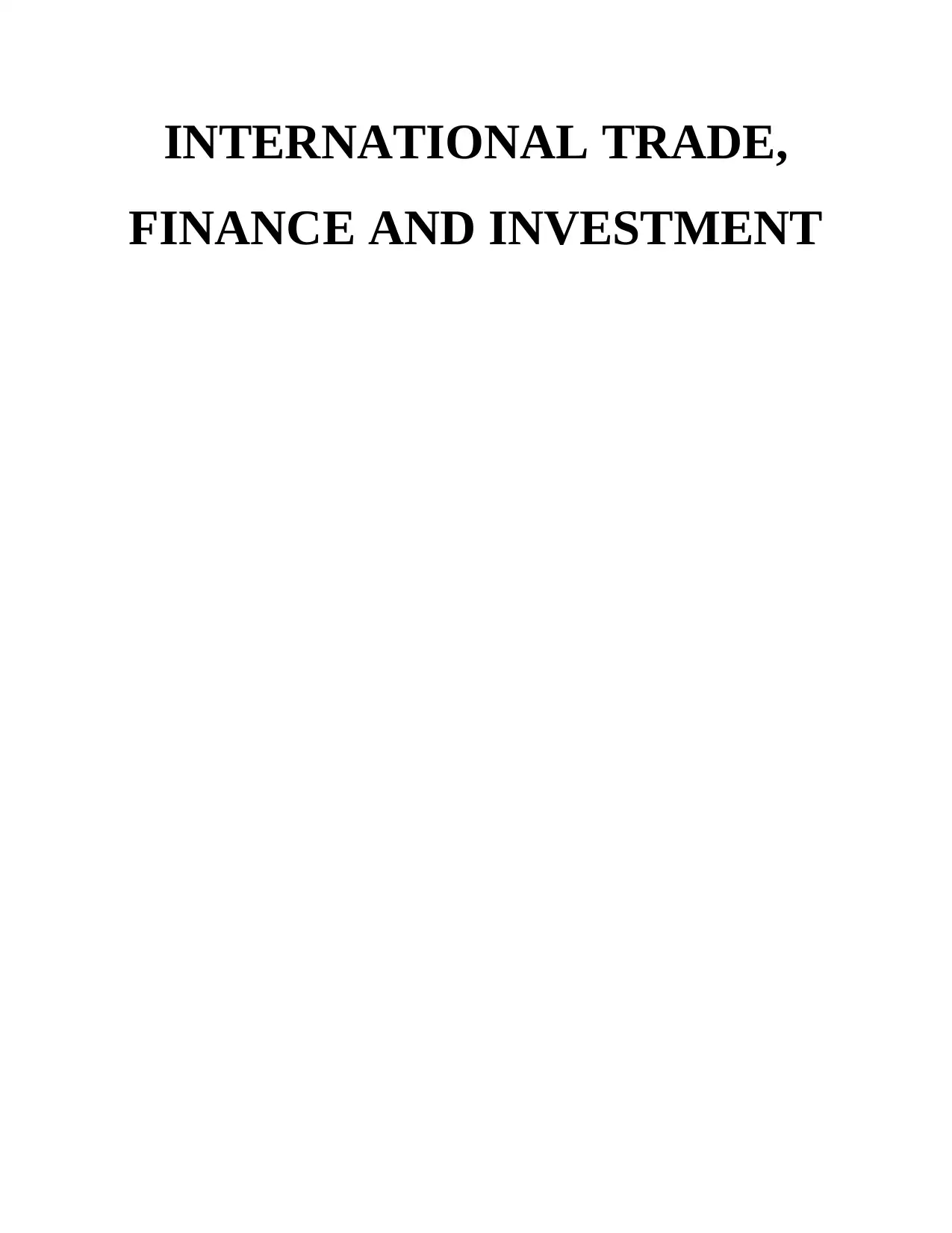
INTERNATIONAL TRADE,
FINANCE AND INVESTMENT
FINANCE AND INVESTMENT
Paraphrase This Document
Need a fresh take? Get an instant paraphrase of this document with our AI Paraphraser
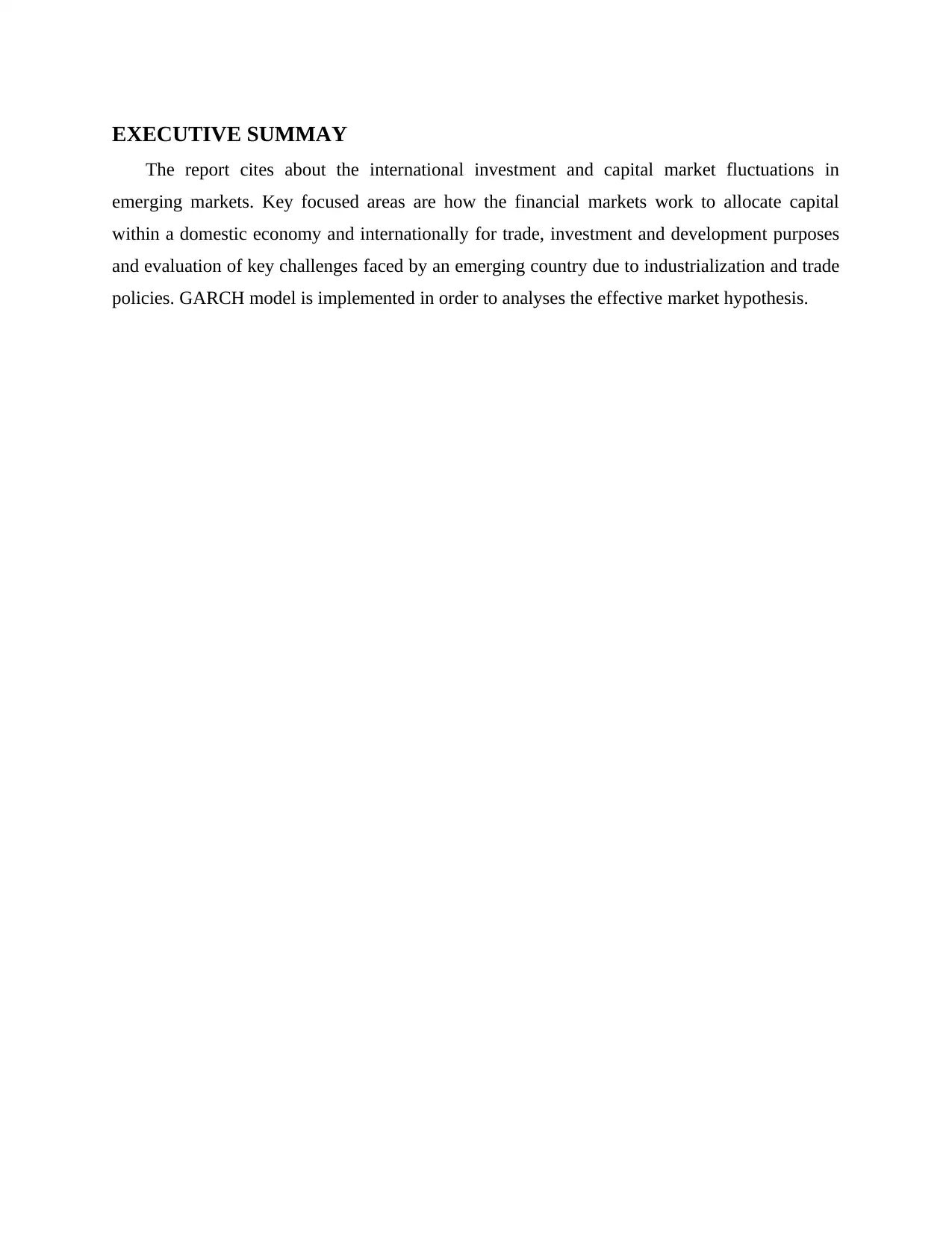
EXECUTIVE SUMMAY
The report cites about the international investment and capital market fluctuations in
emerging markets. Key focused areas are how the financial markets work to allocate capital
within a domestic economy and internationally for trade, investment and development purposes
and evaluation of key challenges faced by an emerging country due to industrialization and trade
policies. GARCH model is implemented in order to analyses the effective market hypothesis.
The report cites about the international investment and capital market fluctuations in
emerging markets. Key focused areas are how the financial markets work to allocate capital
within a domestic economy and internationally for trade, investment and development purposes
and evaluation of key challenges faced by an emerging country due to industrialization and trade
policies. GARCH model is implemented in order to analyses the effective market hypothesis.
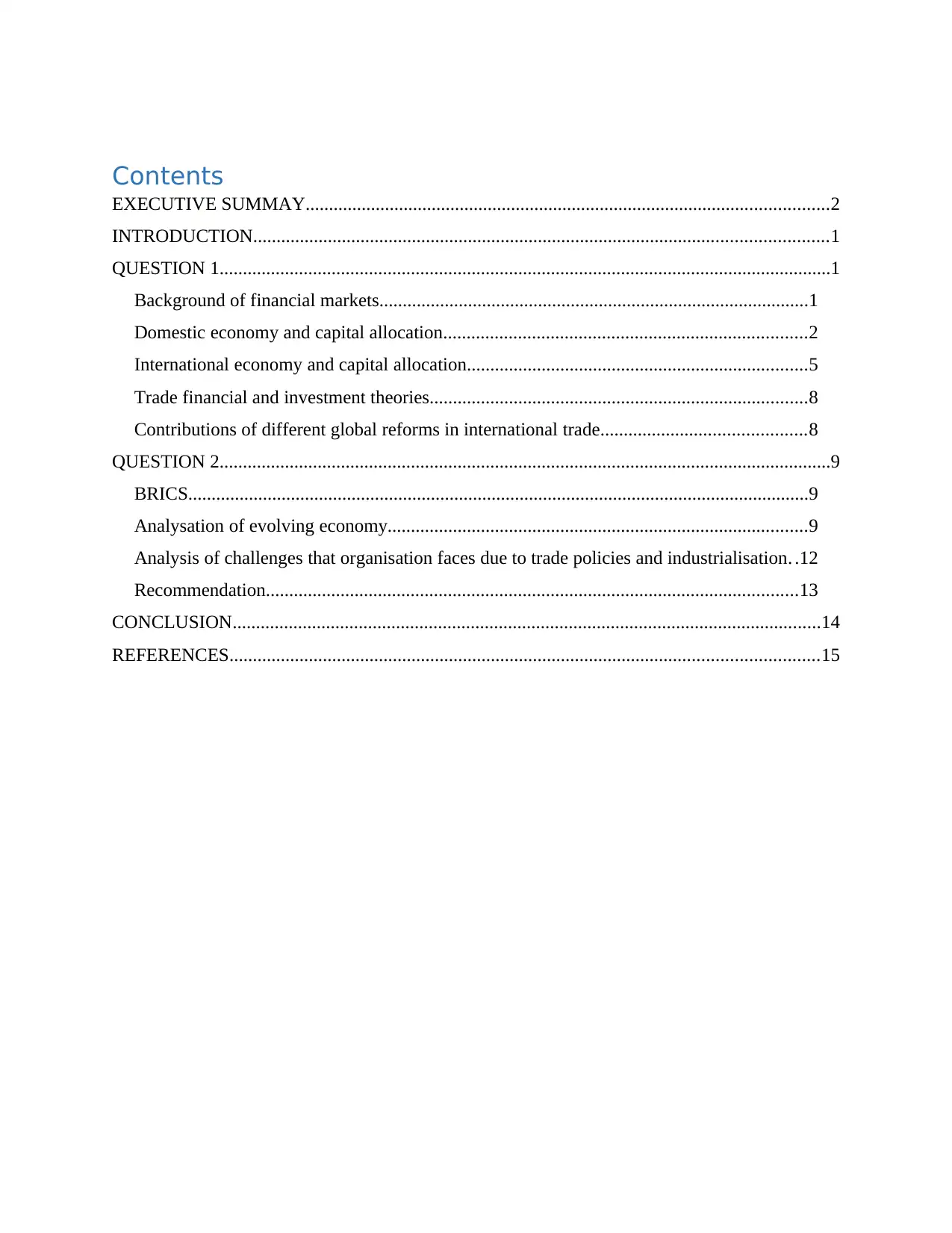
Contents
EXECUTIVE SUMMAY................................................................................................................2
INTRODUCTION...........................................................................................................................1
QUESTION 1...................................................................................................................................1
Background of financial markets............................................................................................1
Domestic economy and capital allocation..............................................................................2
International economy and capital allocation.........................................................................5
Trade financial and investment theories.................................................................................8
Contributions of different global reforms in international trade............................................8
QUESTION 2...................................................................................................................................9
BRICS.....................................................................................................................................9
Analysation of evolving economy..........................................................................................9
Analysis of challenges that organisation faces due to trade policies and industrialisation. .12
Recommendation..................................................................................................................13
CONCLUSION..............................................................................................................................14
REFERENCES..............................................................................................................................15
EXECUTIVE SUMMAY................................................................................................................2
INTRODUCTION...........................................................................................................................1
QUESTION 1...................................................................................................................................1
Background of financial markets............................................................................................1
Domestic economy and capital allocation..............................................................................2
International economy and capital allocation.........................................................................5
Trade financial and investment theories.................................................................................8
Contributions of different global reforms in international trade............................................8
QUESTION 2...................................................................................................................................9
BRICS.....................................................................................................................................9
Analysation of evolving economy..........................................................................................9
Analysis of challenges that organisation faces due to trade policies and industrialisation. .12
Recommendation..................................................................................................................13
CONCLUSION..............................................................................................................................14
REFERENCES..............................................................................................................................15
⊘ This is a preview!⊘
Do you want full access?
Subscribe today to unlock all pages.

Trusted by 1+ million students worldwide
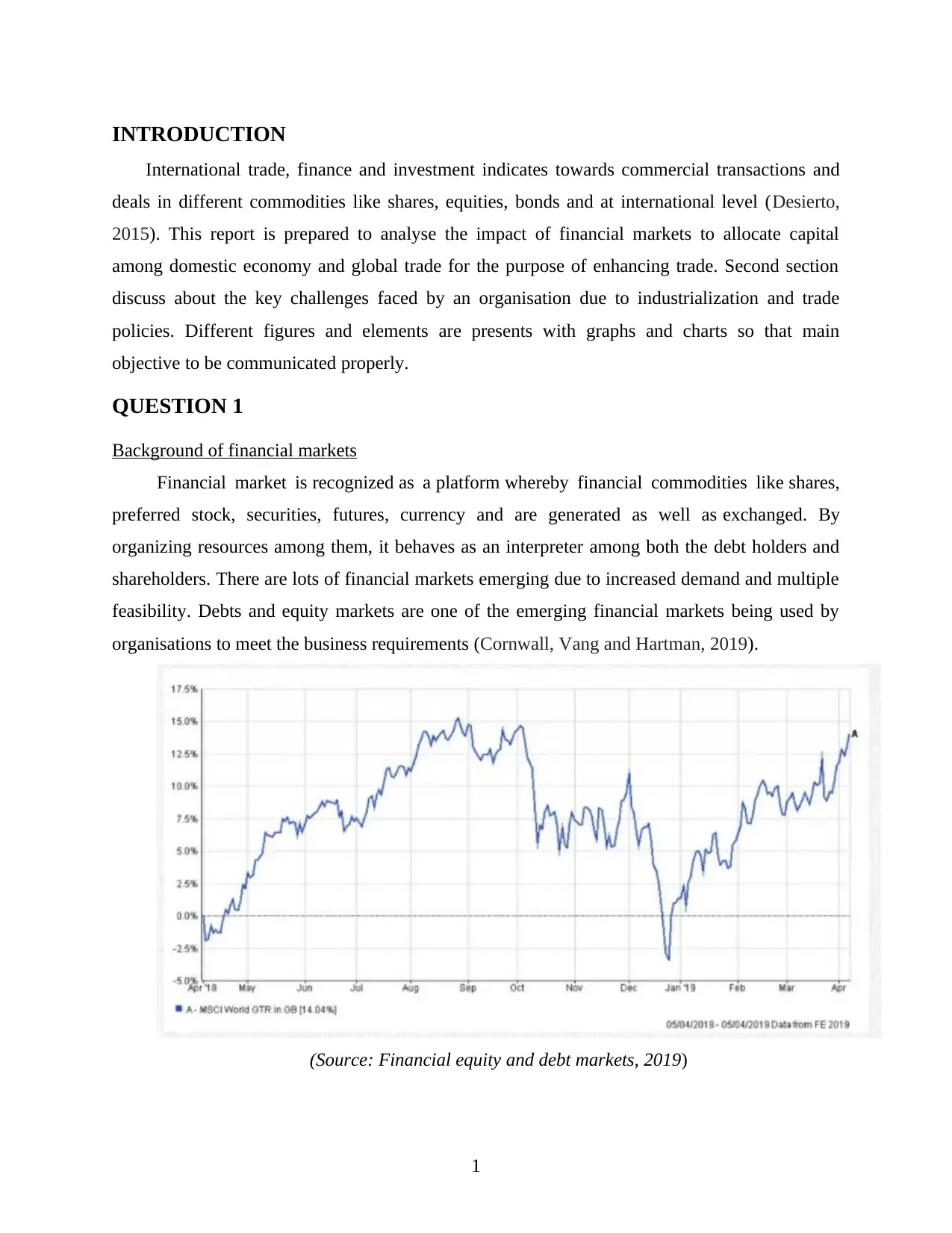
INTRODUCTION
International trade, finance and investment indicates towards commercial transactions and
deals in different commodities like shares, equities, bonds and at international level (Desierto,
2015). This report is prepared to analyse the impact of financial markets to allocate capital
among domestic economy and global trade for the purpose of enhancing trade. Second section
discuss about the key challenges faced by an organisation due to industrialization and trade
policies. Different figures and elements are presents with graphs and charts so that main
objective to be communicated properly.
QUESTION 1
Background of financial markets
Financial market is recognized as a platform whereby financial commodities like shares,
preferred stock, securities, futures, currency and are generated as well as exchanged. By
organizing resources among them, it behaves as an interpreter among both the debt holders and
shareholders. There are lots of financial markets emerging due to increased demand and multiple
feasibility. Debts and equity markets are one of the emerging financial markets being used by
organisations to meet the business requirements (Cornwall, Vang and Hartman, 2019).
(Source: Financial equity and debt markets, 2019)
1
International trade, finance and investment indicates towards commercial transactions and
deals in different commodities like shares, equities, bonds and at international level (Desierto,
2015). This report is prepared to analyse the impact of financial markets to allocate capital
among domestic economy and global trade for the purpose of enhancing trade. Second section
discuss about the key challenges faced by an organisation due to industrialization and trade
policies. Different figures and elements are presents with graphs and charts so that main
objective to be communicated properly.
QUESTION 1
Background of financial markets
Financial market is recognized as a platform whereby financial commodities like shares,
preferred stock, securities, futures, currency and are generated as well as exchanged. By
organizing resources among them, it behaves as an interpreter among both the debt holders and
shareholders. There are lots of financial markets emerging due to increased demand and multiple
feasibility. Debts and equity markets are one of the emerging financial markets being used by
organisations to meet the business requirements (Cornwall, Vang and Hartman, 2019).
(Source: Financial equity and debt markets, 2019)
1
Paraphrase This Document
Need a fresh take? Get an instant paraphrase of this document with our AI Paraphraser
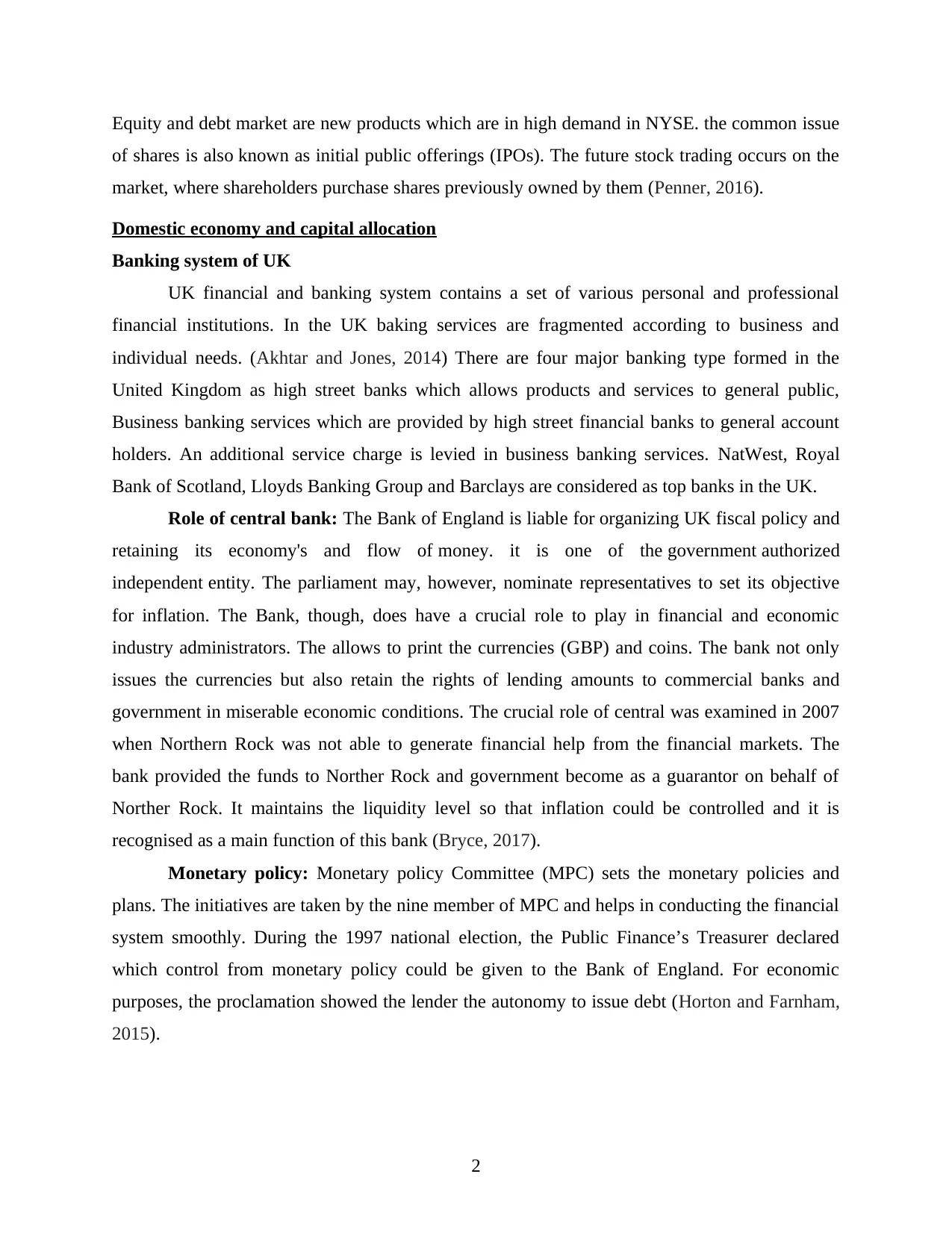
Equity and debt market are new products which are in high demand in NYSE. the common issue
of shares is also known as initial public offerings (IPOs). The future stock trading occurs on the
market, where shareholders purchase shares previously owned by them (Penner, 2016).
Domestic economy and capital allocation
Banking system of UK
UK financial and banking system contains a set of various personal and professional
financial institutions. In the UK baking services are fragmented according to business and
individual needs. (Akhtar and Jones, 2014) There are four major banking type formed in the
United Kingdom as high street banks which allows products and services to general public,
Business banking services which are provided by high street financial banks to general account
holders. An additional service charge is levied in business banking services. NatWest, Royal
Bank of Scotland, Lloyds Banking Group and Barclays are considered as top banks in the UK.
Role of central bank: The Bank of England is liable for organizing UK fiscal policy and
retaining its economy's and flow of money. it is one of the government authorized
independent entity. The parliament may, however, nominate representatives to set its objective
for inflation. The Bank, though, does have a crucial role to play in financial and economic
industry administrators. The allows to print the currencies (GBP) and coins. The bank not only
issues the currencies but also retain the rights of lending amounts to commercial banks and
government in miserable economic conditions. The crucial role of central was examined in 2007
when Northern Rock was not able to generate financial help from the financial markets. The
bank provided the funds to Norther Rock and government become as a guarantor on behalf of
Norther Rock. It maintains the liquidity level so that inflation could be controlled and it is
recognised as a main function of this bank (Bryce, 2017).
Monetary policy: Monetary policy Committee (MPC) sets the monetary policies and
plans. The initiatives are taken by the nine member of MPC and helps in conducting the financial
system smoothly. During the 1997 national election, the Public Finance’s Treasurer declared
which control from monetary policy could be given to the Bank of England. For economic
purposes, the proclamation showed the lender the autonomy to issue debt (Horton and Farnham,
2015).
2
of shares is also known as initial public offerings (IPOs). The future stock trading occurs on the
market, where shareholders purchase shares previously owned by them (Penner, 2016).
Domestic economy and capital allocation
Banking system of UK
UK financial and banking system contains a set of various personal and professional
financial institutions. In the UK baking services are fragmented according to business and
individual needs. (Akhtar and Jones, 2014) There are four major banking type formed in the
United Kingdom as high street banks which allows products and services to general public,
Business banking services which are provided by high street financial banks to general account
holders. An additional service charge is levied in business banking services. NatWest, Royal
Bank of Scotland, Lloyds Banking Group and Barclays are considered as top banks in the UK.
Role of central bank: The Bank of England is liable for organizing UK fiscal policy and
retaining its economy's and flow of money. it is one of the government authorized
independent entity. The parliament may, however, nominate representatives to set its objective
for inflation. The Bank, though, does have a crucial role to play in financial and economic
industry administrators. The allows to print the currencies (GBP) and coins. The bank not only
issues the currencies but also retain the rights of lending amounts to commercial banks and
government in miserable economic conditions. The crucial role of central was examined in 2007
when Northern Rock was not able to generate financial help from the financial markets. The
bank provided the funds to Norther Rock and government become as a guarantor on behalf of
Norther Rock. It maintains the liquidity level so that inflation could be controlled and it is
recognised as a main function of this bank (Bryce, 2017).
Monetary policy: Monetary policy Committee (MPC) sets the monetary policies and
plans. The initiatives are taken by the nine member of MPC and helps in conducting the financial
system smoothly. During the 1997 national election, the Public Finance’s Treasurer declared
which control from monetary policy could be given to the Bank of England. For economic
purposes, the proclamation showed the lender the autonomy to issue debt (Horton and Farnham,
2015).
2
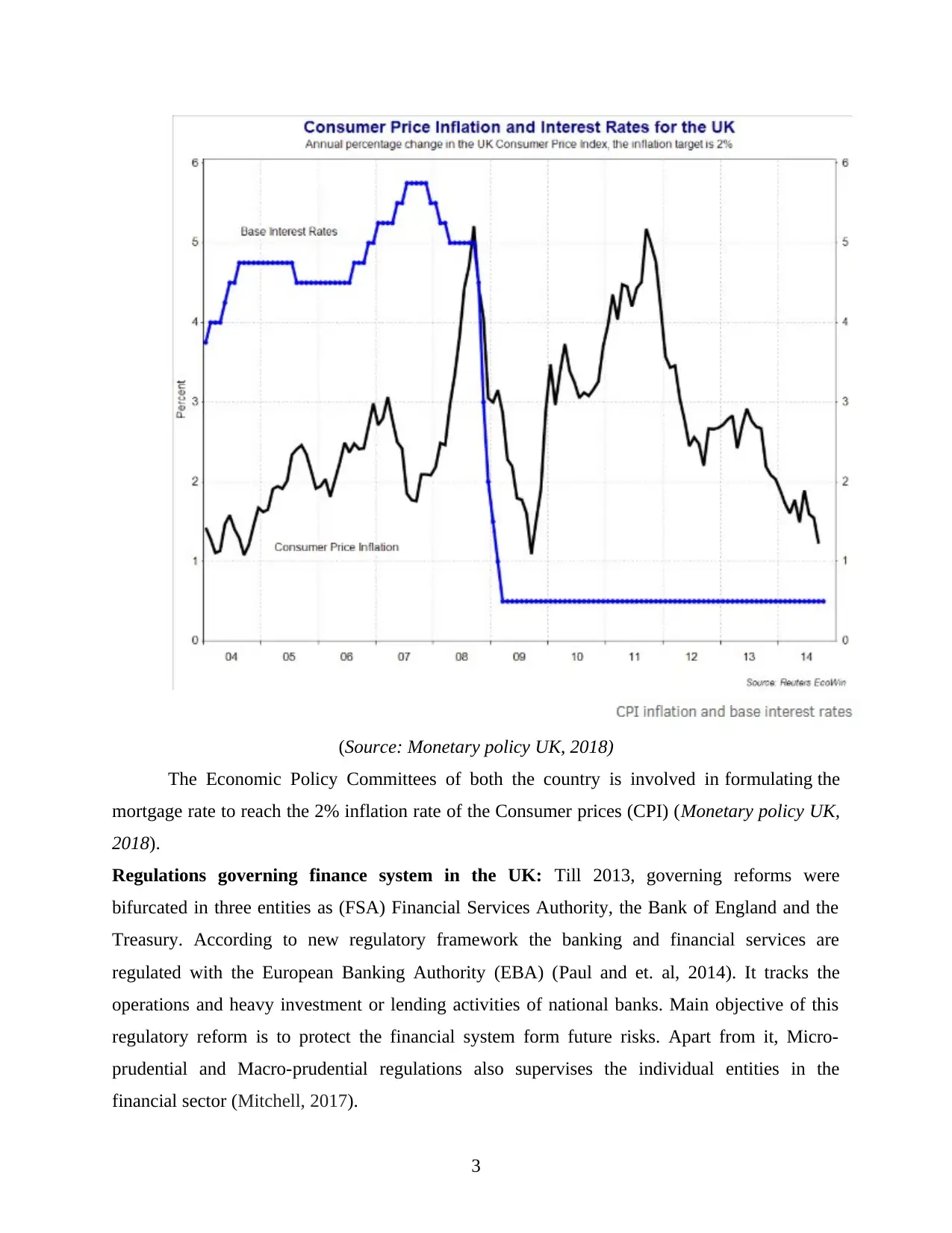
(Source: Monetary policy UK, 2018)
The Economic Policy Committees of both the country is involved in formulating the
mortgage rate to reach the 2% inflation rate of the Consumer prices (CPI) (Monetary policy UK,
2018).
Regulations governing finance system in the UK: Till 2013, governing reforms were
bifurcated in three entities as (FSA) Financial Services Authority, the Bank of England and the
Treasury. According to new regulatory framework the banking and financial services are
regulated with the European Banking Authority (EBA) (Paul and et. al, 2014). It tracks the
operations and heavy investment or lending activities of national banks. Main objective of this
regulatory reform is to protect the financial system form future risks. Apart from it, Micro-
prudential and Macro-prudential regulations also supervises the individual entities in the
financial sector (Mitchell, 2017).
3
The Economic Policy Committees of both the country is involved in formulating the
mortgage rate to reach the 2% inflation rate of the Consumer prices (CPI) (Monetary policy UK,
2018).
Regulations governing finance system in the UK: Till 2013, governing reforms were
bifurcated in three entities as (FSA) Financial Services Authority, the Bank of England and the
Treasury. According to new regulatory framework the banking and financial services are
regulated with the European Banking Authority (EBA) (Paul and et. al, 2014). It tracks the
operations and heavy investment or lending activities of national banks. Main objective of this
regulatory reform is to protect the financial system form future risks. Apart from it, Micro-
prudential and Macro-prudential regulations also supervises the individual entities in the
financial sector (Mitchell, 2017).
3
⊘ This is a preview!⊘
Do you want full access?
Subscribe today to unlock all pages.

Trusted by 1+ million students worldwide
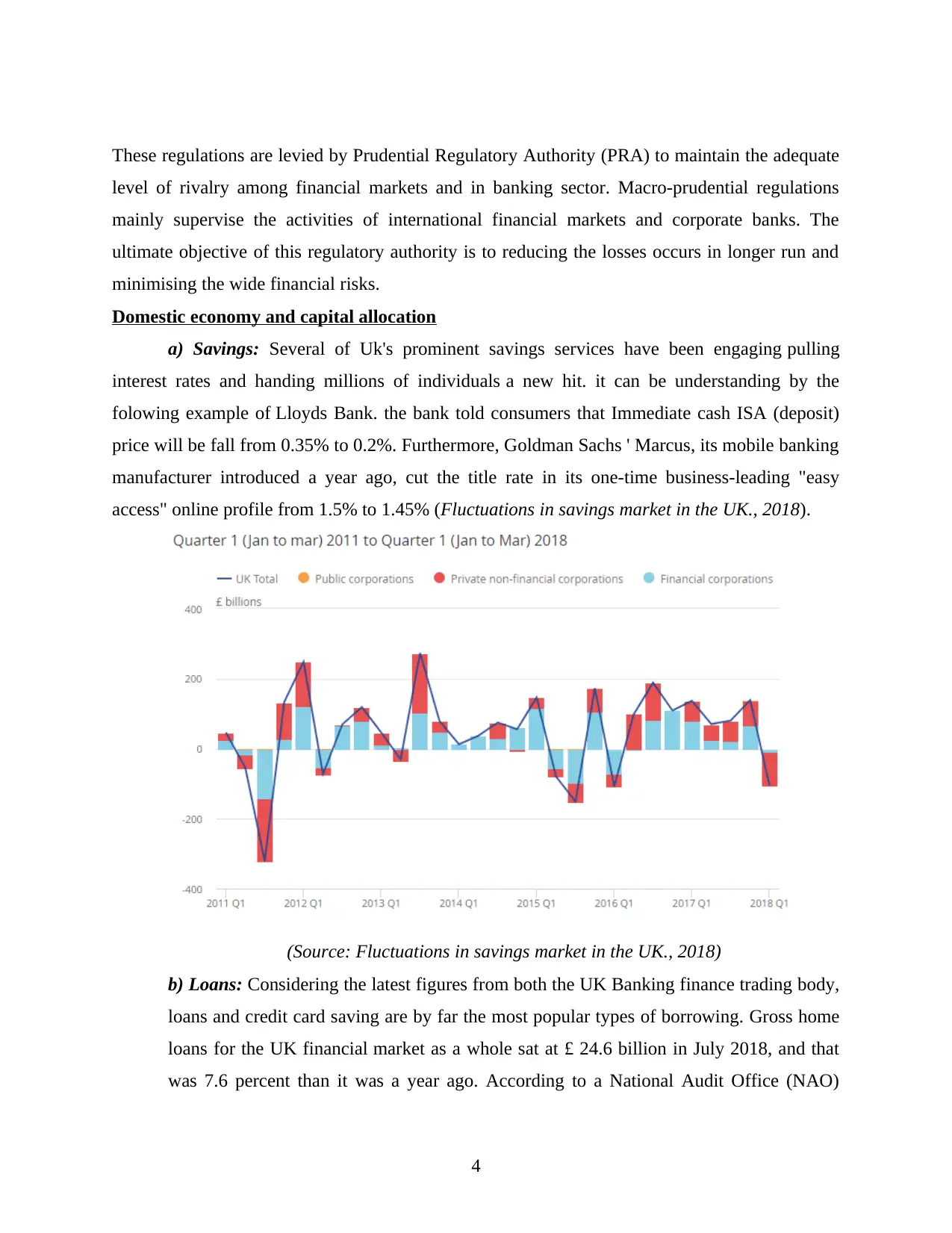
These regulations are levied by Prudential Regulatory Authority (PRA) to maintain the adequate
level of rivalry among financial markets and in banking sector. Macro-prudential regulations
mainly supervise the activities of international financial markets and corporate banks. The
ultimate objective of this regulatory authority is to reducing the losses occurs in longer run and
minimising the wide financial risks.
Domestic economy and capital allocation
a) Savings: Several of Uk's prominent savings services have been engaging pulling
interest rates and handing millions of individuals a new hit. it can be understanding by the
folowing example of Lloyds Bank. the bank told consumers that Immediate cash ISA (deposit)
price will be fall from 0.35% to 0.2%. Furthermore, Goldman Sachs ' Marcus, its mobile banking
manufacturer introduced a year ago, cut the title rate in its one-time business-leading "easy
access" online profile from 1.5% to 1.45% (Fluctuations in savings market in the UK., 2018).
(Source: Fluctuations in savings market in the UK., 2018)
b) Loans: Considering the latest figures from both the UK Banking finance trading body,
loans and credit card saving are by far the most popular types of borrowing. Gross home
loans for the UK financial market as a whole sat at £ 24.6 billion in July 2018, and that
was 7.6 percent than it was a year ago. According to a National Audit Office (NAO)
4
level of rivalry among financial markets and in banking sector. Macro-prudential regulations
mainly supervise the activities of international financial markets and corporate banks. The
ultimate objective of this regulatory authority is to reducing the losses occurs in longer run and
minimising the wide financial risks.
Domestic economy and capital allocation
a) Savings: Several of Uk's prominent savings services have been engaging pulling
interest rates and handing millions of individuals a new hit. it can be understanding by the
folowing example of Lloyds Bank. the bank told consumers that Immediate cash ISA (deposit)
price will be fall from 0.35% to 0.2%. Furthermore, Goldman Sachs ' Marcus, its mobile banking
manufacturer introduced a year ago, cut the title rate in its one-time business-leading "easy
access" online profile from 1.5% to 1.45% (Fluctuations in savings market in the UK., 2018).
(Source: Fluctuations in savings market in the UK., 2018)
b) Loans: Considering the latest figures from both the UK Banking finance trading body,
loans and credit card saving are by far the most popular types of borrowing. Gross home
loans for the UK financial market as a whole sat at £ 24.6 billion in July 2018, and that
was 7.6 percent than it was a year ago. According to a National Audit Office (NAO)
4
Paraphrase This Document
Need a fresh take? Get an instant paraphrase of this document with our AI Paraphraser
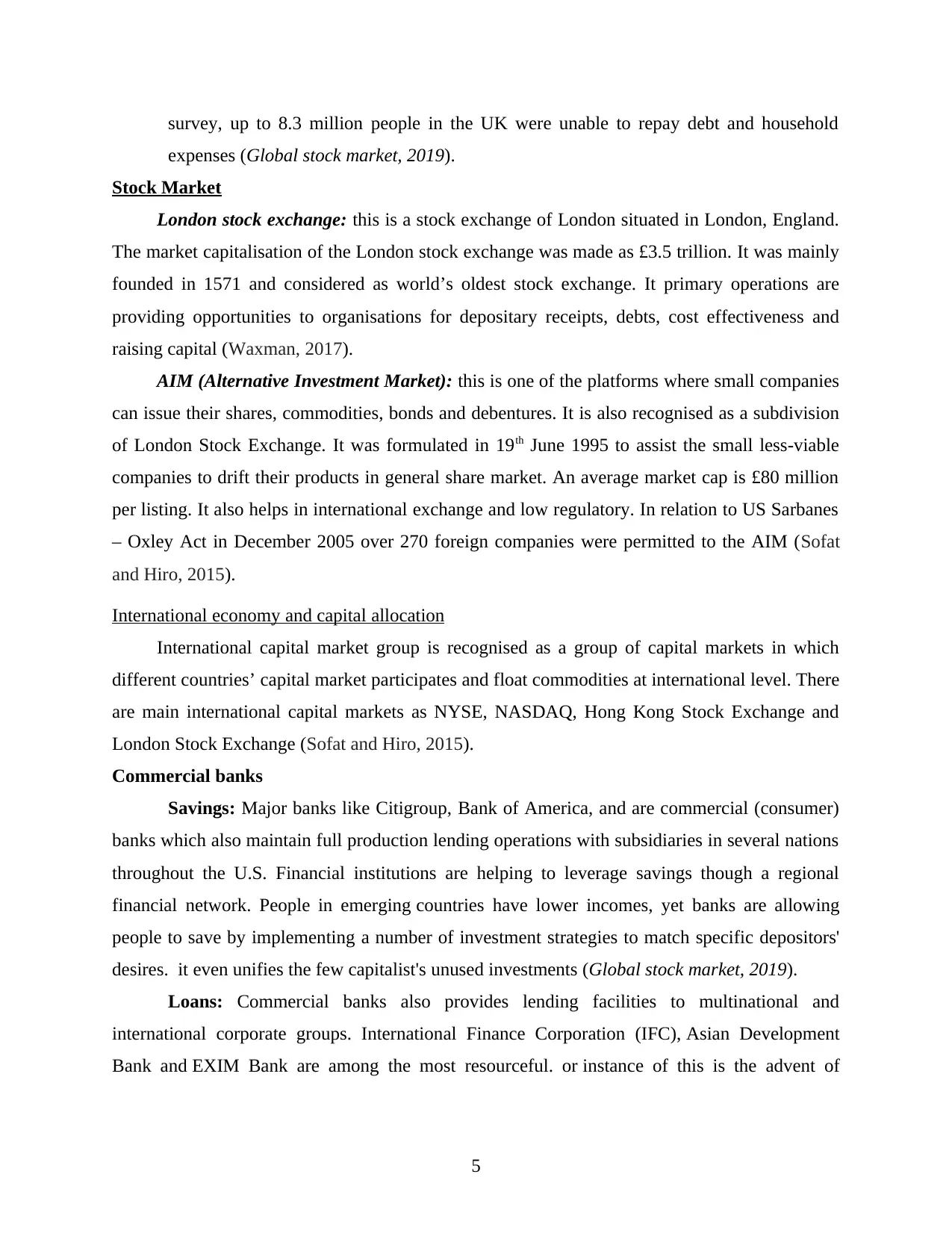
survey, up to 8.3 million people in the UK were unable to repay debt and household
expenses (Global stock market, 2019).
Stock Market
London stock exchange: this is a stock exchange of London situated in London, England.
The market capitalisation of the London stock exchange was made as £3.5 trillion. It was mainly
founded in 1571 and considered as world’s oldest stock exchange. It primary operations are
providing opportunities to organisations for depositary receipts, debts, cost effectiveness and
raising capital (Waxman, 2017).
AIM (Alternative Investment Market): this is one of the platforms where small companies
can issue their shares, commodities, bonds and debentures. It is also recognised as a subdivision
of London Stock Exchange. It was formulated in 19th June 1995 to assist the small less-viable
companies to drift their products in general share market. An average market cap is £80 million
per listing. It also helps in international exchange and low regulatory. In relation to US Sarbanes
– Oxley Act in December 2005 over 270 foreign companies were permitted to the AIM (Sofat
and Hiro, 2015).
International economy and capital allocation
International capital market group is recognised as a group of capital markets in which
different countries’ capital market participates and float commodities at international level. There
are main international capital markets as NYSE, NASDAQ, Hong Kong Stock Exchange and
London Stock Exchange (Sofat and Hiro, 2015).
Commercial banks
Savings: Major banks like Citigroup, Bank of America, and are commercial (consumer)
banks which also maintain full production lending operations with subsidiaries in several nations
throughout the U.S. Financial institutions are helping to leverage savings though a regional
financial network. People in emerging countries have lower incomes, yet banks are allowing
people to save by implementing a number of investment strategies to match specific depositors'
desires. it even unifies the few capitalist's unused investments (Global stock market, 2019).
Loans: Commercial banks also provides lending facilities to multinational and
international corporate groups. International Finance Corporation (IFC), Asian Development
Bank and EXIM Bank are among the most resourceful. or instance of this is the advent of
5
expenses (Global stock market, 2019).
Stock Market
London stock exchange: this is a stock exchange of London situated in London, England.
The market capitalisation of the London stock exchange was made as £3.5 trillion. It was mainly
founded in 1571 and considered as world’s oldest stock exchange. It primary operations are
providing opportunities to organisations for depositary receipts, debts, cost effectiveness and
raising capital (Waxman, 2017).
AIM (Alternative Investment Market): this is one of the platforms where small companies
can issue their shares, commodities, bonds and debentures. It is also recognised as a subdivision
of London Stock Exchange. It was formulated in 19th June 1995 to assist the small less-viable
companies to drift their products in general share market. An average market cap is £80 million
per listing. It also helps in international exchange and low regulatory. In relation to US Sarbanes
– Oxley Act in December 2005 over 270 foreign companies were permitted to the AIM (Sofat
and Hiro, 2015).
International economy and capital allocation
International capital market group is recognised as a group of capital markets in which
different countries’ capital market participates and float commodities at international level. There
are main international capital markets as NYSE, NASDAQ, Hong Kong Stock Exchange and
London Stock Exchange (Sofat and Hiro, 2015).
Commercial banks
Savings: Major banks like Citigroup, Bank of America, and are commercial (consumer)
banks which also maintain full production lending operations with subsidiaries in several nations
throughout the U.S. Financial institutions are helping to leverage savings though a regional
financial network. People in emerging countries have lower incomes, yet banks are allowing
people to save by implementing a number of investment strategies to match specific depositors'
desires. it even unifies the few capitalist's unused investments (Global stock market, 2019).
Loans: Commercial banks also provides lending facilities to multinational and
international corporate groups. International Finance Corporation (IFC), Asian Development
Bank and EXIM Bank are among the most resourceful. or instance of this is the advent of
5
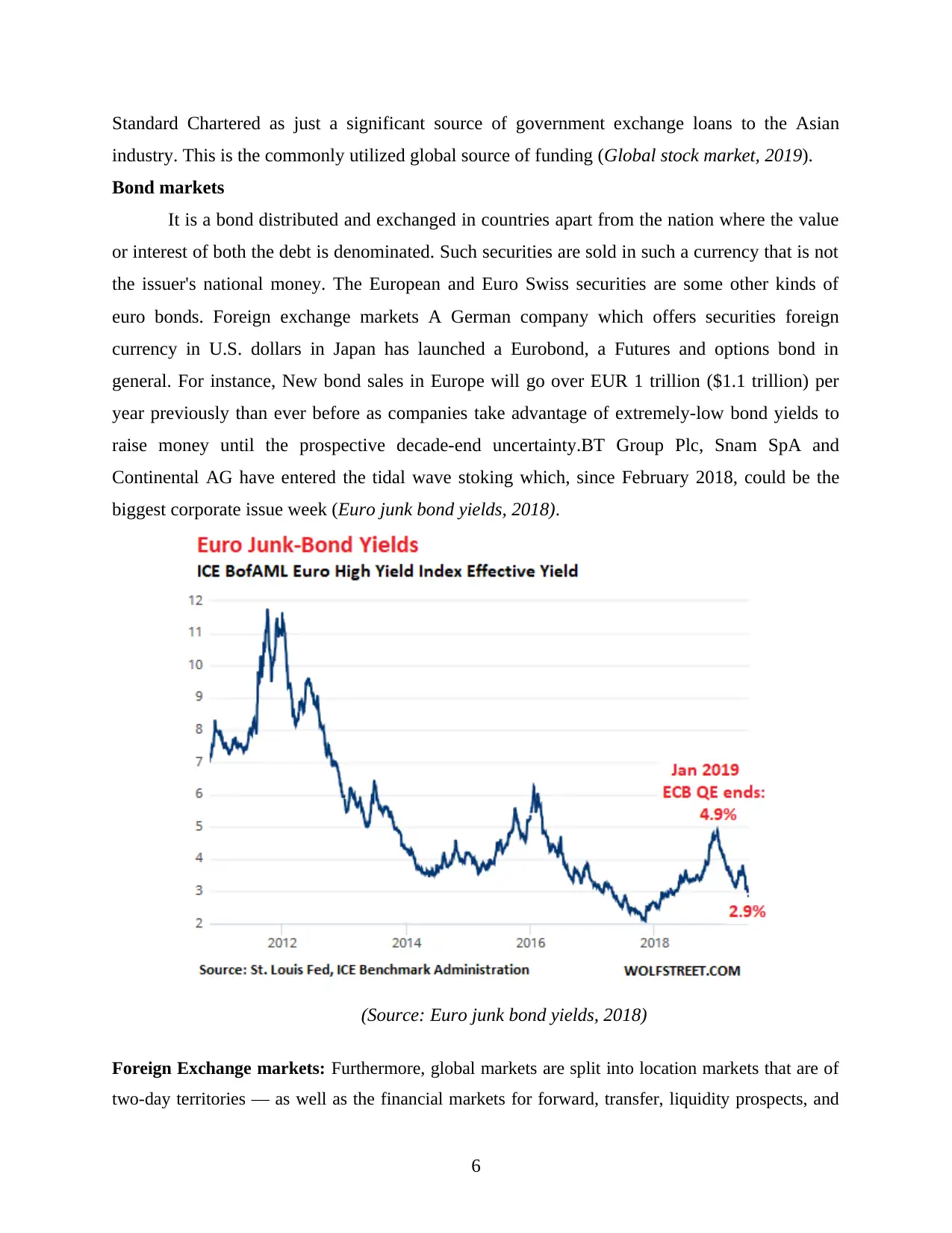
Standard Chartered as just a significant source of government exchange loans to the Asian
industry. This is the commonly utilized global source of funding (Global stock market, 2019).
Bond markets
It is a bond distributed and exchanged in countries apart from the nation where the value
or interest of both the debt is denominated. Such securities are sold in such a currency that is not
the issuer's national money. The European and Euro Swiss securities are some other kinds of
euro bonds. Foreign exchange markets A German company which offers securities foreign
currency in U.S. dollars in Japan has launched a Eurobond, a Futures and options bond in
general. For instance, New bond sales in Europe will go over EUR 1 trillion ($1.1 trillion) per
year previously than ever before as companies take advantage of extremely-low bond yields to
raise money until the prospective decade-end uncertainty.BT Group Plc, Snam SpA and
Continental AG have entered the tidal wave stoking which, since February 2018, could be the
biggest corporate issue week (Euro junk bond yields, 2018).
(Source: Euro junk bond yields, 2018)
Foreign Exchange markets: Furthermore, global markets are split into location markets that are of
two-day territories — as well as the financial markets for forward, transfer, liquidity prospects, and
6
industry. This is the commonly utilized global source of funding (Global stock market, 2019).
Bond markets
It is a bond distributed and exchanged in countries apart from the nation where the value
or interest of both the debt is denominated. Such securities are sold in such a currency that is not
the issuer's national money. The European and Euro Swiss securities are some other kinds of
euro bonds. Foreign exchange markets A German company which offers securities foreign
currency in U.S. dollars in Japan has launched a Eurobond, a Futures and options bond in
general. For instance, New bond sales in Europe will go over EUR 1 trillion ($1.1 trillion) per
year previously than ever before as companies take advantage of extremely-low bond yields to
raise money until the prospective decade-end uncertainty.BT Group Plc, Snam SpA and
Continental AG have entered the tidal wave stoking which, since February 2018, could be the
biggest corporate issue week (Euro junk bond yields, 2018).
(Source: Euro junk bond yields, 2018)
Foreign Exchange markets: Furthermore, global markets are split into location markets that are of
two-day territories — as well as the financial markets for forward, transfer, liquidity prospects, and
6
⊘ This is a preview!⊘
Do you want full access?
Subscribe today to unlock all pages.

Trusted by 1+ million students worldwide
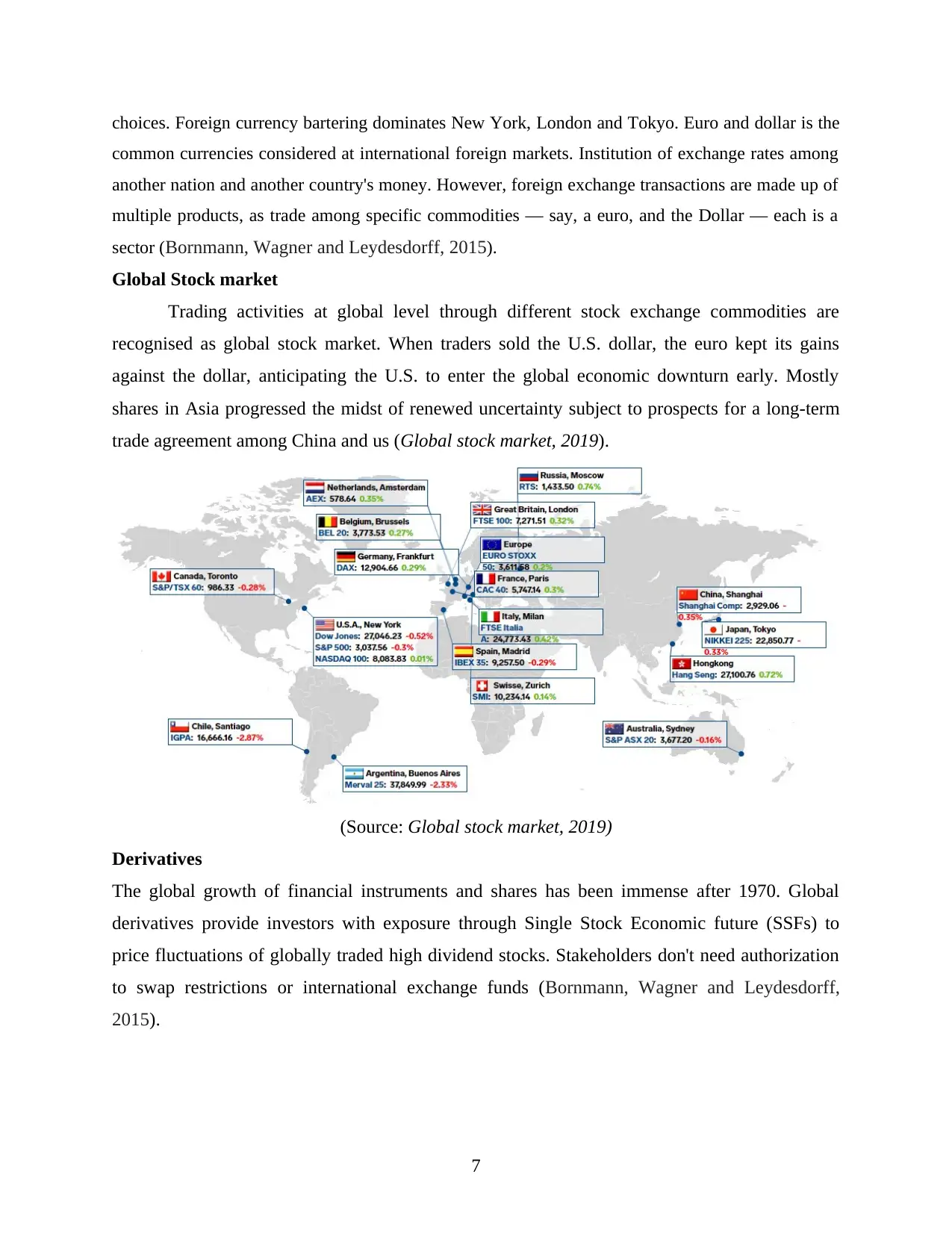
choices. Foreign currency bartering dominates New York, London and Tokyo. Euro and dollar is the
common currencies considered at international foreign markets. Institution of exchange rates among
another nation and another country's money. However, foreign exchange transactions are made up of
multiple products, as trade among specific commodities — say, a euro, and the Dollar — each is a
sector (Bornmann, Wagner and Leydesdorff, 2015).
Global Stock market
Trading activities at global level through different stock exchange commodities are
recognised as global stock market. When traders sold the U.S. dollar, the euro kept its gains
against the dollar, anticipating the U.S. to enter the global economic downturn early. Mostly
shares in Asia progressed the midst of renewed uncertainty subject to prospects for a long-term
trade agreement among China and us (Global stock market, 2019).
(Source: Global stock market, 2019)
Derivatives
The global growth of financial instruments and shares has been immense after 1970. Global
derivatives provide investors with exposure through Single Stock Economic future (SSFs) to
price fluctuations of globally traded high dividend stocks. Stakeholders don't need authorization
to swap restrictions or international exchange funds (Bornmann, Wagner and Leydesdorff,
2015).
7
common currencies considered at international foreign markets. Institution of exchange rates among
another nation and another country's money. However, foreign exchange transactions are made up of
multiple products, as trade among specific commodities — say, a euro, and the Dollar — each is a
sector (Bornmann, Wagner and Leydesdorff, 2015).
Global Stock market
Trading activities at global level through different stock exchange commodities are
recognised as global stock market. When traders sold the U.S. dollar, the euro kept its gains
against the dollar, anticipating the U.S. to enter the global economic downturn early. Mostly
shares in Asia progressed the midst of renewed uncertainty subject to prospects for a long-term
trade agreement among China and us (Global stock market, 2019).
(Source: Global stock market, 2019)
Derivatives
The global growth of financial instruments and shares has been immense after 1970. Global
derivatives provide investors with exposure through Single Stock Economic future (SSFs) to
price fluctuations of globally traded high dividend stocks. Stakeholders don't need authorization
to swap restrictions or international exchange funds (Bornmann, Wagner and Leydesdorff,
2015).
7
Paraphrase This Document
Need a fresh take? Get an instant paraphrase of this document with our AI Paraphraser
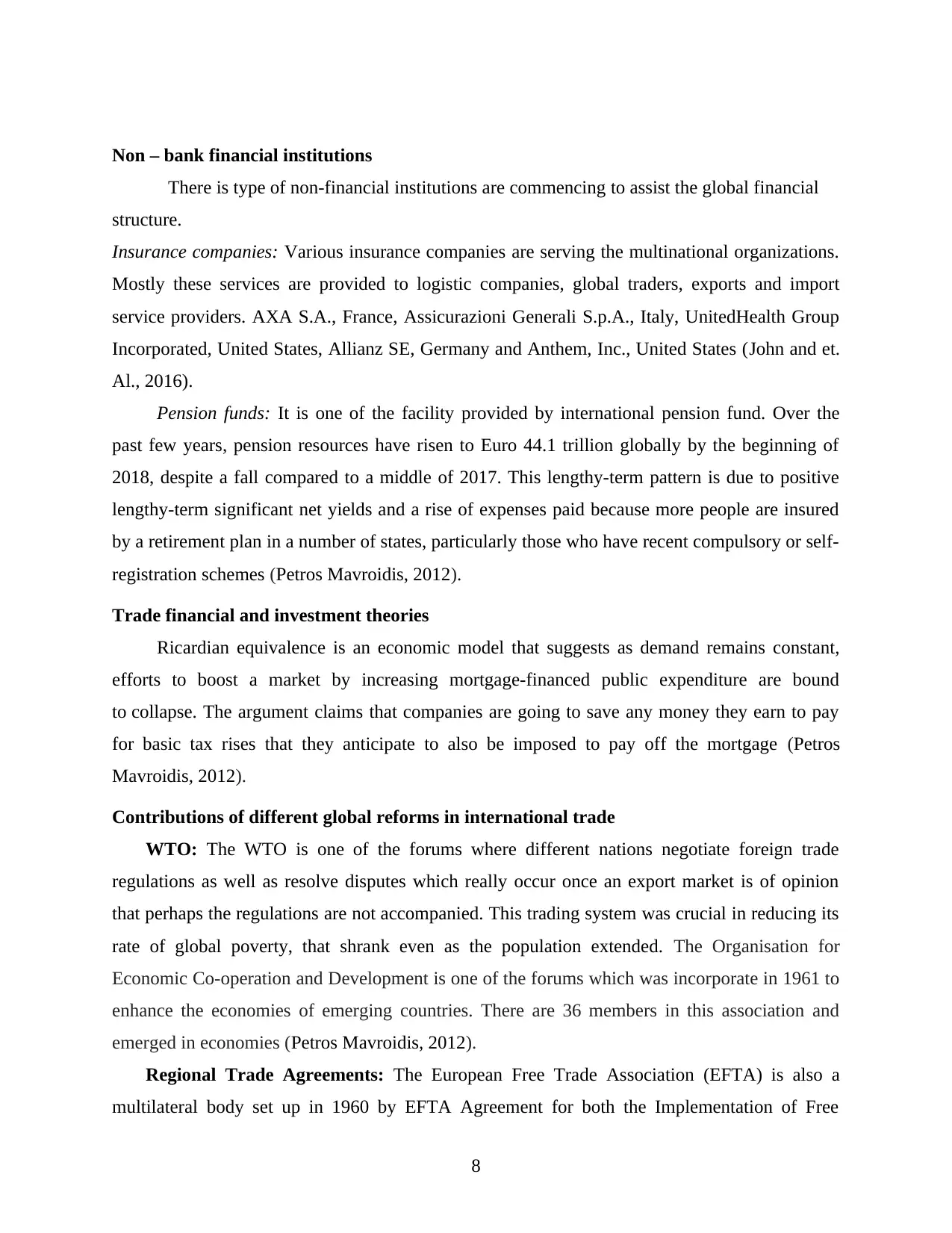
Non – bank financial institutions
There is type of non-financial institutions are commencing to assist the global financial
structure.
Insurance companies: Various insurance companies are serving the multinational organizations.
Mostly these services are provided to logistic companies, global traders, exports and import
service providers. AXA S.A., France, Assicurazioni Generali S.p.A., Italy, UnitedHealth Group
Incorporated, United States, Allianz SE, Germany and Anthem, Inc., United States (John and et.
Al., 2016).
Pension funds: It is one of the facility provided by international pension fund. Over the
past few years, pension resources have risen to Euro 44.1 trillion globally by the beginning of
2018, despite a fall compared to a middle of 2017. This lengthy-term pattern is due to positive
lengthy-term significant net yields and a rise of expenses paid because more people are insured
by a retirement plan in a number of states, particularly those who have recent compulsory or self-
registration schemes (Petros Mavroidis, 2012).
Trade financial and investment theories
Ricardian equivalence is an economic model that suggests as demand remains constant,
efforts to boost a market by increasing mortgage-financed public expenditure are bound
to collapse. The argument claims that companies are going to save any money they earn to pay
for basic tax rises that they anticipate to also be imposed to pay off the mortgage (Petros
Mavroidis, 2012).
Contributions of different global reforms in international trade
WTO: The WTO is one of the forums where different nations negotiate foreign trade
regulations as well as resolve disputes which really occur once an export market is of opinion
that perhaps the regulations are not accompanied. This trading system was crucial in reducing its
rate of global poverty, that shrank even as the population extended. The Organisation for
Economic Co-operation and Development is one of the forums which was incorporate in 1961 to
enhance the economies of emerging countries. There are 36 members in this association and
emerged in economies (Petros Mavroidis, 2012).
Regional Trade Agreements: The European Free Trade Association (EFTA) is also a
multilateral body set up in 1960 by EFTA Agreement for both the Implementation of Free
8
There is type of non-financial institutions are commencing to assist the global financial
structure.
Insurance companies: Various insurance companies are serving the multinational organizations.
Mostly these services are provided to logistic companies, global traders, exports and import
service providers. AXA S.A., France, Assicurazioni Generali S.p.A., Italy, UnitedHealth Group
Incorporated, United States, Allianz SE, Germany and Anthem, Inc., United States (John and et.
Al., 2016).
Pension funds: It is one of the facility provided by international pension fund. Over the
past few years, pension resources have risen to Euro 44.1 trillion globally by the beginning of
2018, despite a fall compared to a middle of 2017. This lengthy-term pattern is due to positive
lengthy-term significant net yields and a rise of expenses paid because more people are insured
by a retirement plan in a number of states, particularly those who have recent compulsory or self-
registration schemes (Petros Mavroidis, 2012).
Trade financial and investment theories
Ricardian equivalence is an economic model that suggests as demand remains constant,
efforts to boost a market by increasing mortgage-financed public expenditure are bound
to collapse. The argument claims that companies are going to save any money they earn to pay
for basic tax rises that they anticipate to also be imposed to pay off the mortgage (Petros
Mavroidis, 2012).
Contributions of different global reforms in international trade
WTO: The WTO is one of the forums where different nations negotiate foreign trade
regulations as well as resolve disputes which really occur once an export market is of opinion
that perhaps the regulations are not accompanied. This trading system was crucial in reducing its
rate of global poverty, that shrank even as the population extended. The Organisation for
Economic Co-operation and Development is one of the forums which was incorporate in 1961 to
enhance the economies of emerging countries. There are 36 members in this association and
emerged in economies (Petros Mavroidis, 2012).
Regional Trade Agreements: The European Free Trade Association (EFTA) is also a
multilateral body set up in 1960 by EFTA Agreement for both the Implementation of Free
8
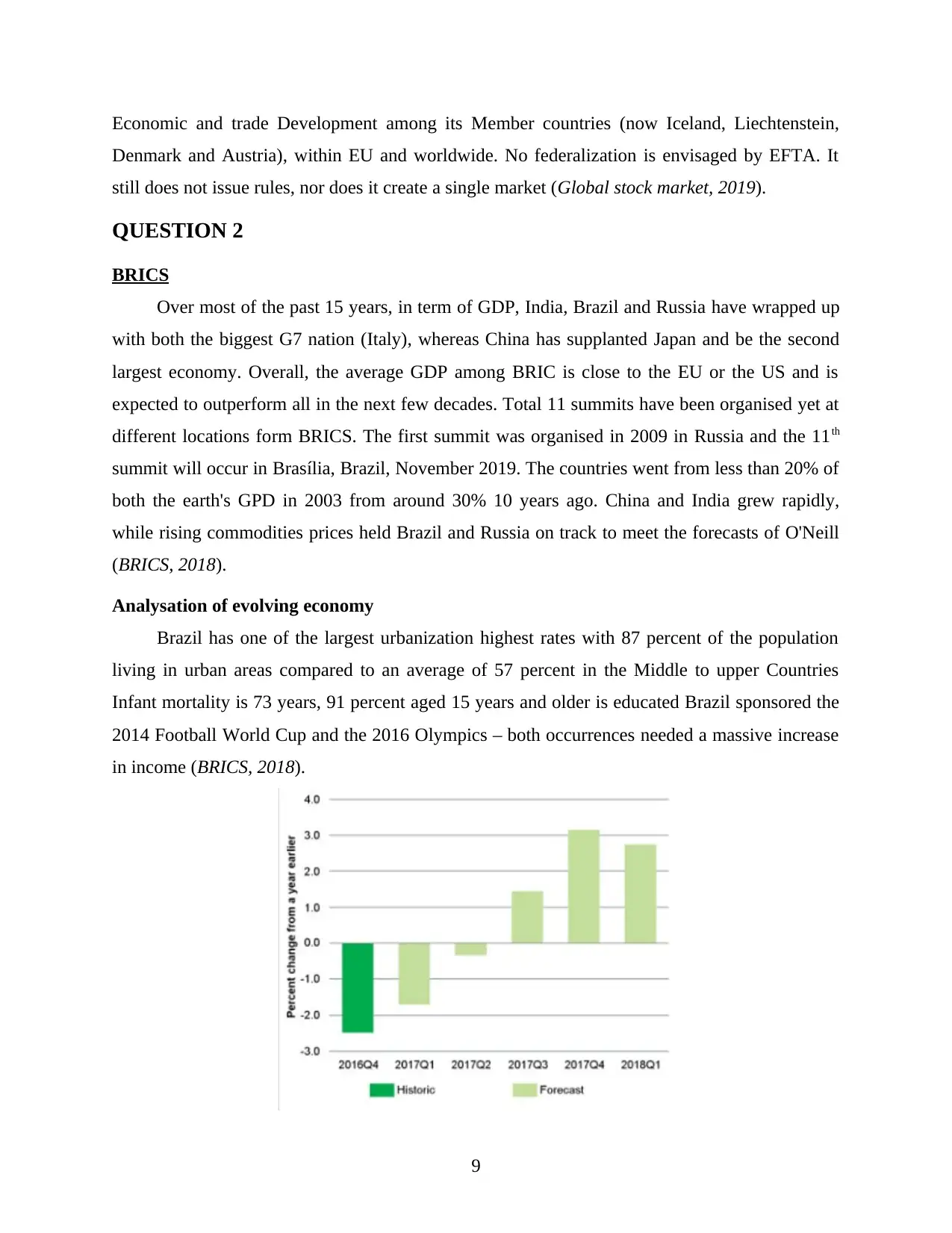
Economic and trade Development among its Member countries (now Iceland, Liechtenstein,
Denmark and Austria), within EU and worldwide. No federalization is envisaged by EFTA. It
still does not issue rules, nor does it create a single market (Global stock market, 2019).
QUESTION 2
BRICS
Over most of the past 15 years, in term of GDP, India, Brazil and Russia have wrapped up
with both the biggest G7 nation (Italy), whereas China has supplanted Japan and be the second
largest economy. Overall, the average GDP among BRIC is close to the EU or the US and is
expected to outperform all in the next few decades. Total 11 summits have been organised yet at
different locations form BRICS. The first summit was organised in 2009 in Russia and the 11th
summit will occur in Brasília, Brazil, November 2019. The countries went from less than 20% of
both the earth's GPD in 2003 from around 30% 10 years ago. China and India grew rapidly,
while rising commodities prices held Brazil and Russia on track to meet the forecasts of O'Neill
(BRICS, 2018).
Analysation of evolving economy
Brazil has one of the largest urbanization highest rates with 87 percent of the population
living in urban areas compared to an average of 57 percent in the Middle to upper Countries
Infant mortality is 73 years, 91 percent aged 15 years and older is educated Brazil sponsored the
2014 Football World Cup and the 2016 Olympics – both occurrences needed a massive increase
in income (BRICS, 2018).
9
Denmark and Austria), within EU and worldwide. No federalization is envisaged by EFTA. It
still does not issue rules, nor does it create a single market (Global stock market, 2019).
QUESTION 2
BRICS
Over most of the past 15 years, in term of GDP, India, Brazil and Russia have wrapped up
with both the biggest G7 nation (Italy), whereas China has supplanted Japan and be the second
largest economy. Overall, the average GDP among BRIC is close to the EU or the US and is
expected to outperform all in the next few decades. Total 11 summits have been organised yet at
different locations form BRICS. The first summit was organised in 2009 in Russia and the 11th
summit will occur in Brasília, Brazil, November 2019. The countries went from less than 20% of
both the earth's GPD in 2003 from around 30% 10 years ago. China and India grew rapidly,
while rising commodities prices held Brazil and Russia on track to meet the forecasts of O'Neill
(BRICS, 2018).
Analysation of evolving economy
Brazil has one of the largest urbanization highest rates with 87 percent of the population
living in urban areas compared to an average of 57 percent in the Middle to upper Countries
Infant mortality is 73 years, 91 percent aged 15 years and older is educated Brazil sponsored the
2014 Football World Cup and the 2016 Olympics – both occurrences needed a massive increase
in income (BRICS, 2018).
9
⊘ This is a preview!⊘
Do you want full access?
Subscribe today to unlock all pages.

Trusted by 1+ million students worldwide
1 out of 19
Related Documents
Your All-in-One AI-Powered Toolkit for Academic Success.
+13062052269
info@desklib.com
Available 24*7 on WhatsApp / Email
![[object Object]](/_next/static/media/star-bottom.7253800d.svg)
Unlock your academic potential
Copyright © 2020–2025 A2Z Services. All Rights Reserved. Developed and managed by ZUCOL.





